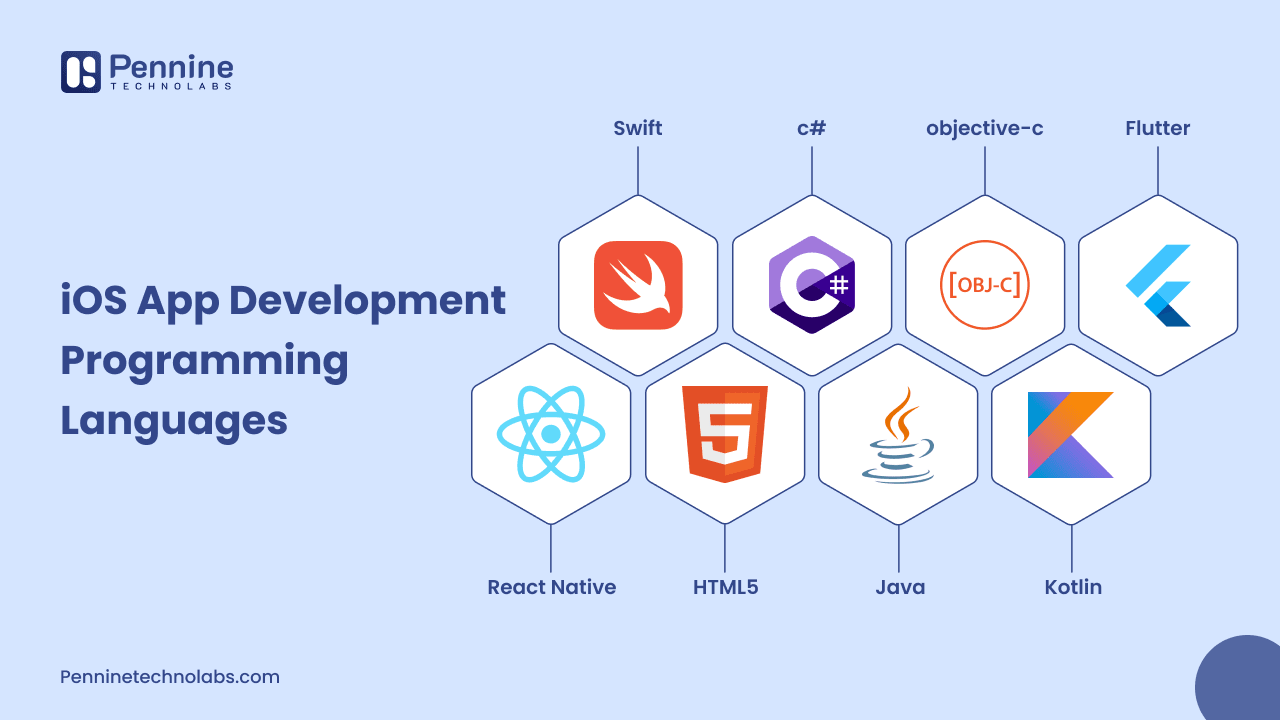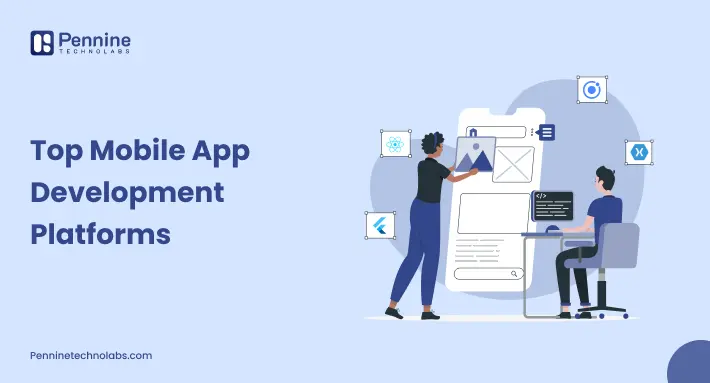Quick Summary: Selecting the correct programming language is essential for high-performance and user-friendly iOS apps in 2025. From Swift to Kotlin, each language has unique benefits for iOS app developers. This blog explores the top iOS programming language, its features and why to choose Pennine Technolabs for your iOS app development.
Have you ever questioned yourself about what drives the apps you use on your iPhone or iPad on a daily basis? There is a mighty programming language behind all these smooth experiences to make them possible. iOS is dynamic, and with it, there are also changes in tools and languages that developers rely on to create safe, quick, and entertaining mobile apps.
Businesses are in need of scalable and future-proof iOS solutions in 2025. Be it creating an app to order or enhancing an existing application, knowing which programming language would suit your vision can be the difference between the two. Check out the most popular and functional programming languages shaping iOS app development this year.
What is an iOS Programming Language?
An iOS programming language is the core foundation used to create applications for Apple’s operating system. It determines the behavior of an app, its interaction with the user, and its interaction with Apple’s hardware and software ecosystem. These languages enable iOS app developers to create applications that can be used on iPhones, iPads, and other Apple devices with applications such as Xcode, SwiftUI, and others.
Apple’s iOS ecosystem has grown over the years, which no longer includes native development, and the list of preferred tools now includes cross-platform frameworks and modern languages.
Trending Programming Languages for iOS App Development in 2025
As the iOS landscape grows, developers now have more options than ever. Here are the top languages expected to grow in 2025:
1. Swift
Swift is the officially recommended and most suggested language for iOS app development. Swift is known to be fast, secure and easy to use and allows developers to create modern and reliable apps efficiently.
Swift Key Features:
- Open source and beginner-friendly.
- Strong type security prevents coding mistakes.
- Quick performance over Objective-C.
- Excellent support by Apple and a large developer community.
- Complements Xcode and SwiftUI.
Swift is perfect for start-ups and businesses that need to be scaled and supported in the long term.
2. Objective-C
Before Swift, Objective-C was used as the primary language in iOS applications. It continues to be used in the maintenance of older projects or the integration of older systems.
Objective-C Key Features:
- Mature and stable after decades of use.
- Supports C and C++ libraries.
- Allows runtime flexibility and dynamic typing.
- Broad library support and backward compatibility.
Objective-C is being used, although to a large extent, in favour of Swift, when an app needs to be compatible or maintained with earlier versions.
3. C#
C# is a powerful option to develop iOS apps with such frameworks as Xamarin and .NET MAUI. It is familiar with developers who are interested in cross-platform compatibility.
C# Key Features:
- Allows iOS, Android and Windows code sharing.
- Delivers a high-quality performance and a native interface.
- Supported by a robust ecosystem of Microsoft.
- Easy integration with cloud-based services.
C# is an excellent choice for business applications that require a single codebase to work across multiple platforms without compromising quality.
4. Flutter (Dart)
Flutter, designed by Google’s Dart language, has changed the mobile app development model through its single codebase model. It is becoming a massive momentum in the development of iOS due to its expressive user interface and high performance.
Flutter Key Features:
- Delivers iOS and Android applications from the same code.
- Attractive UI through widgets and animation.
- Native like performance and a rapid rendering engine.
- Quick development using the Hot Reload feature.
Flutter is best suited to those businesses that are concerned about providing rich user experiences and shorter time to launch in the market.
5. React Native (JavaScript)
React Native is still the most popular language in cross-platform application development, which is maintained by Meta. It is based on the principles of JavaScript and React to create high-quality mobile applications.
React Native Key Features:
- One codebase for both iOS and Android.
- Reusable UI components
- Huge developer community and third-party support.
- Native API Integration is easy.
React Native has been favoured as a startup tool that offers fast and affordable iOS applications with real-time updates and a modern UI.
6. HTML5
The combination of HTML5, CSS and JavaScript allows developers to develop hybrid iOS applications that can be rendered inside a web view.
HTML5 Key Features:
- Cost-effective development for heavy or simple apps.
- Easy maintenance and development.
- Supports progressive web applications (PWA) well.
- Cross-platform compatibility
Even though it’s not a native performance platform, HTML5 can be used in products that are web-first and need cross-device access.
7. Java
Traditionally used for Android, Java may also be applied to the development of iOS applications with frameworks such as Codename One.
Java Key Features:
- Mature and widely supported
- Easy to learn and scalable
- iOS compatibility with various frameworks
- Very Strong library support
Java is a likely choice when a mobile app developer wants to improve coverage of the iOS ecosystem.
8. Kotlin
Kotlin is growing extensively outside Android as a cross-platform solution; frameworks like Kotlin Multiplatform Mobile (KMM) allow it to be used on iOS.
Kotlin Key Features:
- Modern, concise syntax
- Shared business logic cross-platform support.
- Complete Java interoperability.
- Strong tooling and IDE support.
Kotlin is ideal for teams that develop apps on both platforms and preserve clean and consistent codebases.
Best iOS App Development Programming Languages 2025
It’s 2025, Swift remains the market leader for native iOS applications, and Flutter and React Native are already leading the cross-platform platforms. C# still enjoys enterprise-level projects, and Kotlin is gaining popularity as a cross-platform language. Scalability, maintenance, and performance are some of the factors used by businesses when selecting languages instead of popularity.
Why Choose Pennine Technolabs for iOS App Development
The reason to choose Pennine Technolabs for making iOS Apps.
Pennine Technolabs brings innovation and precision to every iOS app development. Our team develop iOS applications with Swift, Flutter, React Native, and other innovative technologies that power high-quality mobile experiences.
What makes us stand out:
- Native and cross-platform iOS experience.
- Focus on performance standards, usability and Apple design standards.
- Tailored solutions for startups, businesses, and online stores.
- Transparent pricing and hiring models for your business.
- Proven track record across the industry
We create digital experiences that meet your business requirements and the standards of the Apple ecosystem.
Conclusion
IOS app development in 2025 is more dynamic than ever. Swift dominates the native development arena, and frameworks such as Flutter and React Native further transform the cross-platform performance. No matter how fast, how scalable, or how cost-efficient it needs to be, choosing the correct programming language is key to mobile app success
Pennine Technolabs ensures the best iOS technologies and strategies to build impactful iOS apps that users love.
FAQs for iOS Programming Language
What is the best programming language for iOS app development in 2025?
Swift is the best language to develop native iOS applications due to its performance, security, and official Apple support.
Can I use Flutter or React Native for iOS development?
Yes, Flutter and React Native both enable developers to develop iOS applications with a shared codebase to save their time and money.
Is Objective-C still used for iOS apps?
Yes, but mostly to keep legacy applications or to integrate them with older systems.
Which language is best for cross-platform iOS development?
The best options for cross-platform apps in 2025 are Flutter (Dart) and React Native (JavaScript).
Why should I choose Pennine Technolabs for my iOS app project?
Pennine Technolabs is a blend of technical experience, novel design and agile development to help you achieve high-performing iOS apps that support your business objectives.


